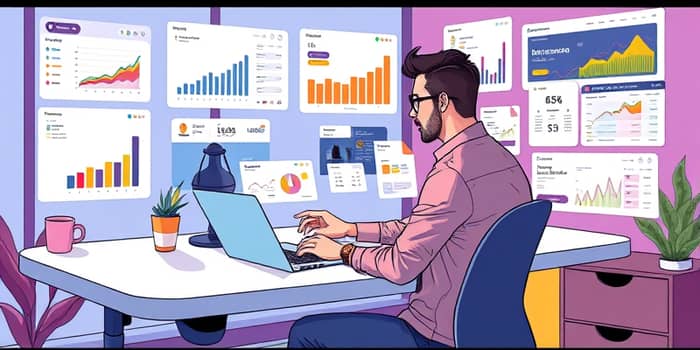Freelancing brings freedom, creativity, and the promise of being your own boss. Yet amid the excitement of independent work, many professionals struggle to manage the complex financial aspects of a business.
By centralizing income tracking, expense management, and forecasting in one place, financial dashboards can empower freelancers to make informed decisions, reduce stress, and focus on their craft rather than administrative tasks.
Understanding Financial Dashboards
A financial dashboard is a centralized hub for managing finances, combining data visualization with actionable insights. It aggregates information from bank accounts, payment platforms, invoices, and expense records, presenting it in clear graphs and charts. This real-time snapshot allows freelancers to see exactly where their money is coming from and where it’s going.
Moreover, dashboards often include tools for automated reconciliation and categorization, minimizing manual data entry and ensuring accuracy. Many dashboards are customizable, allowing you to apply filters, drill down into specific date ranges, and export data for deeper analysis. Plugging into APIs from banks, payment gateways, and accounting software, you can unify disparate sources into one cohesive view.
Color-coded charts, interactive timelines, and customizable widgets let you tailor the interface to match your workflow. This level of personalization makes it easier to focus on what matters—finding profitable clients, spotting cross-project trends, and planning for upcoming expenses.
The Freelance Finance Challenge
Without a dashboard, freelancers face a host of financial pitfalls:
- Poor visibility into cash flow, leading to surprise shortfalls.
- Time-consuming manual invoice creation and follow-up.
- Missed expense deductions, driving up tax bills.
- Difficulty forecasting future earnings and budgeting.
- Inconsistent record-keeping across multiple platforms.
These pain points can translate into missed revenue and increased stress, undermining the freedom freelancing promises.
Imagine waking up one morning to find late fees from unpaid invoices or scrambling to find deductible expenses at tax time. Without organized data, you may overlook key opportunities to optimize cash flow or end up spending hours stitching together spreadsheets.
Core Features to Look For
When evaluating dashboards, consider not just the feature list but how it fits your daily routine. Look for intuitive interfaces, drag-and-drop customization, and responsive support that can help you troubleshoot issues in real time. Here are the capabilities that form the backbone of any robust solution:
- Income Tracking and Visualization: Monitor payments across clients and projects, with milestone and recurring revenue support.
- Expense Management: Categorize costs automatically or manually, and attach receipts for seamless record-keeping.
- Invoicing & Payment Processing: Generate professional invoices, accept credit cards, bank transfers, and send automated reminders for late payments.
- Budgeting and Forecasting: Set spending limits and predict future cash flow based on historical data and seasonal trends.
- Profit & Loss Reporting: Dynamic charts summarizing monthly, quarterly, or yearly performance to gauge financial health.
- Time Tracking Integration: Tie hours worked to invoices and analyze productivity across projects.
- Tax Preparation Tools: Estimate tax obligations, categorize deductible expenses, and export reports for accountants.
- Multi-Currency Support: Consolidate earnings from international clients with live exchange rates.
- Mobile and Desktop Accessibility: Stay on top of finances anywhere, any time.
Some dashboards even offer goal tracking, so you can set revenue targets and visualize progress toward quarterly or annual milestones. Automated alerts can warn you when expenses exceed predefined thresholds or when a large invoice is overdue, prompting timely action.
Top Tools and Platforms
Several platforms stand out in the freelance market for their tailored features and usability. Mint offers a straightforward setup process: link your bank and credit card accounts, and the system automatically categorizes transactions into budgets like marketing, software, or travel. It’s an excellent entry point for freelancers just starting to organize cash flow.
QuickBooks Self-Employed excels at estimating quarterly taxes, pulling together mileage, home office deductions, and income figures into concise tax summaries. For those with a mix of contract and recurring revenue, the built-in invoice templates save time.
Xero brings a full accounting suite with bank reconciliation, inventory tracking, and project management add-ons. It’s ideal for freelancers transitioning into small agency owners who need more comprehensive financial oversight.
Gig Wage leverages AI-powered tools like Gig Wage to draft invoices, cross-reference expense receipts, and automate follow-up communications. Its AI engine learns your preferences and suggests optimizations over time.
Airtable’s Finance Dashboard uses spreadsheet-style flexibility paired with database power. Technically minded freelancers can craft custom views, formulas, and automation scripts to model nearly any financial scenario.
Each tool targets different needs: beginners may prefer free or low-cost options, while growing businesses seek advanced integrations and automation.
Workflow Integration Strategies
Integrating your financial dashboard with existing tools multiplies its benefits. Consider pairing:
- A time-tracking app like Toggl or Clockify to automatically log billable hours.
- A CRM system to pull client details and project milestones directly into invoices.
- A payment processor such as Stripe or PayPal for instant payment updates.
Zapier or Make.com can bridge niche apps to your dashboard, ensuring every time entry, invoice status update, or expense receipt is synced automatically. This low-code approach means you don’t need to hire a developer to connect tools.
For instance, when a new client signs a contract in HelloSign, Zapier can trigger invoice generation in QuickBooks and record the event in your CRM, all without manual intervention. Such seamless workflows cut down on administrative overhead and reduce the risk of human error.
Security and Future Trends
When handling sensitive financial data, security is paramount. Prioritize bank-level encryption and secure backups when selecting a tool. Review privacy policies, ensure two-factor authentication is available, and choose vendors with transparent compliance standards.
Some platforms are exploring blockchain-based ledgers, offering immutable audit trails and enhanced transparency for fund movements. Biometric login methods, such as fingerprint or facial recognition, add another layer of protection when accessing sensitive reports on mobile devices.
Looking forward, predictive analytics and machine learning will power even smarter dashboards. Expect features that automatically flag unusual spending patterns, forecast client payment delays, and recommend optimal budgeting strategies. As AI matures, freelancers will spend less time juggling numbers and more time delivering value.
Conclusion
Freelancers face a unique set of financial challenges, from managing irregular income streams to keeping pace with tax obligations. A purpose-built financial dashboard transforms these hurdles into streamlined processes, offering actionable insights and time savings.
Ultimately, the goal is to build a financial foundation that grows with you. As your freelance venture expands—onboarding new clients, hiring subcontractors, or launching products—you’ll already have a robust system in place to handle increased complexity.
Take time to trial multiple dashboards, lean on free tiers to assess workflows, and engage with community forums or user groups to learn best practices. The right dashboard not only tracks numbers but also inspires confidence, giving you the freedom to innovate and thrive.
References
- https://www.freelancer.com/support/profile/financial-dashboard/
- https://freelancerdashboard.com
- https://www.doola.com/blog/10-best-financial-tools-for-freelancers-in-2024/
- https://www.agencymavericks.com/5-finance-apps-for-your-freelance-business/
- https://uddalak.gumroad.com/l/airtable-finance-dashboard
- https://www.gigwage.com/blog/financial-tools-for-freelancers
- https://databox.com/data-analysis-report
- https://freelancerdashboard.com/freelancer-admin-dashboard/










